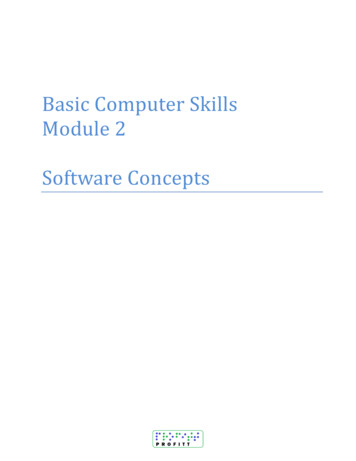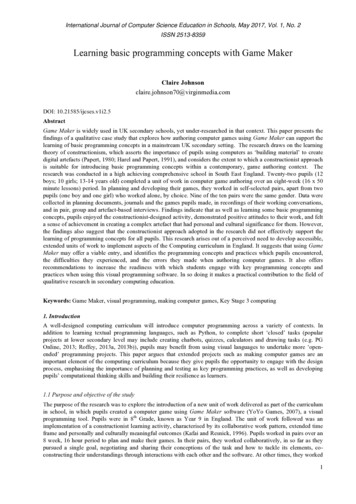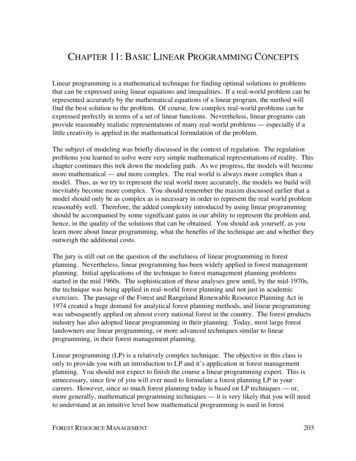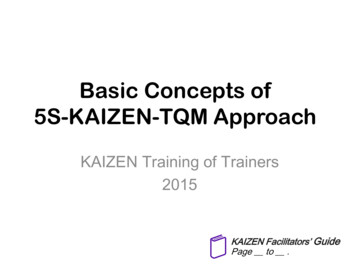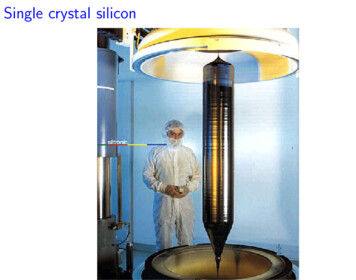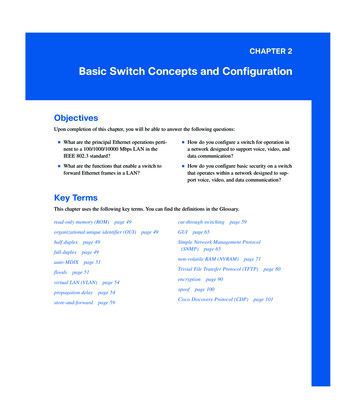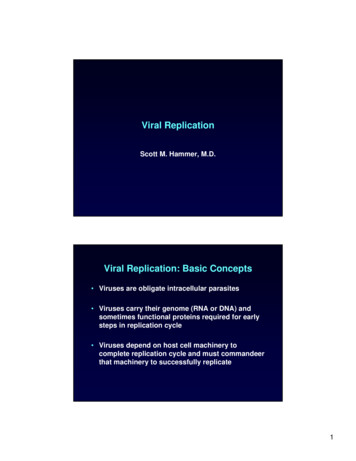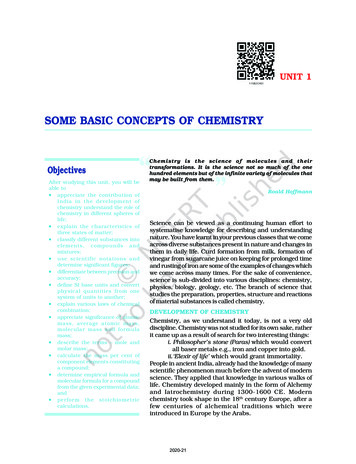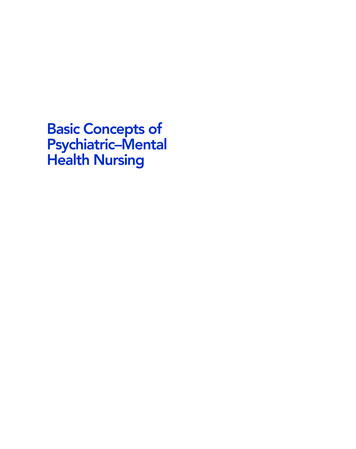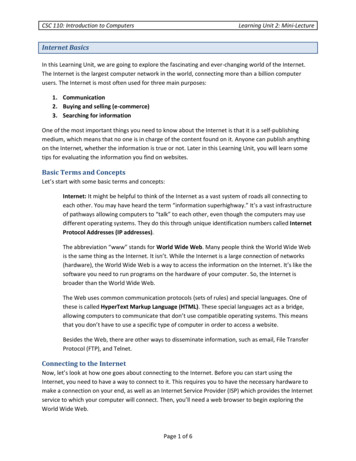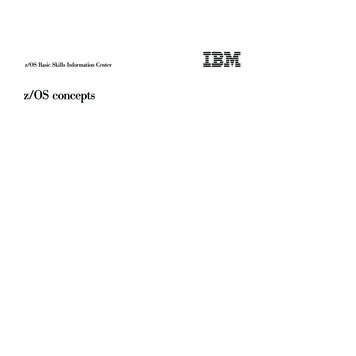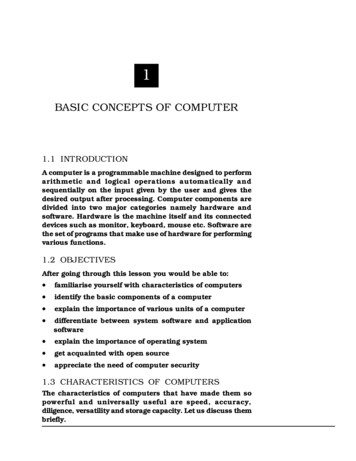
Transcription
Basic Concepts of Computer :: 11BASIC CONCEPTS OF COMPUTER1.1 INTRODUCTIONA computer is a programmable machine designed to performarithmetic and logical operations automatically andsequentially on the input given by the user and gives thedesired output after processing. Computer components aredivided into two major categories namely hardware andsoftware. Hardware is the machine itself and its connecteddevices such as monitor, keyboard, mouse etc. Software arethe set of programs that make use of hardware for performingvarious functions.1.2 OBJECTIVESAfter going through this lesson you would be able to: familiarise yourself with characteristics of computersidentify the basic components of a computerexplain the importance of various units of a computerdifferentiate between system software and applicationsoftwareexplain the importance of operating systemget acquainted with open sourceappreciate the need of computer security1.3 CHARACTERISTICS OF COMPUTERSThe characteristics of computers that have made them sopowerful and universally useful are speed, accuracy,diligence, versatility and storage capacity. Let us discuss thembriefly.
2 :: Computer and Office ApplicationsSpeedComputers work at an incredible speed. A powerful computeris capable of performing about 3-4 million simple instructionsper second.AccuracyIn addition to being fast, computers are also accurate. Errorsthat may occur can almost always be attributed to humanerror (inaccurate data, poorly designed system or faultyinstructions/programs written by the programmer)DiligenceUnlike human beings, computers are highly consistent. Theydo not suffer from human traits of boredom and tirednessresulting in lack of concentration. Computers, therefore, arebetter than human beings in performing voluminous andrepetitive jobs.VersatilityComputers are versatile machines and are capable ofperforming any task as long as it can be broken down into aseries of logical steps. The presence of computers can beseen in almost every sphere – Railway/Air reservation, Banks,Hotels, Weather forecasting and many more.Storage CapacityToday’s computers can store large volumes of data. A pieceof information once recorded (or stored) in the computer,can never be forgotten and can be retrieved almostinstantaneously.1.4 COMPUTER ORGANIZATIONFig.1.1: Computer System
Basic Concepts of Computer :: 3A computer system (fig.1.1) consists of mainly four basicunits; namely input unit, storage unit, central processingunit and output unit. Central Processing unit further includesArithmetic logic unit and control unit, as shown inFigure 1.2.A computer performs five major operations or functionsirrespective of its size and make. These are it accepts data or instructions as input, it stores data and instruction it processes data as per the instructions, it controls all operations inside a computer, and it gives results in the form of output.1.4.1 Functional Units:––––a. Input Unit: This unit is used for entering data andprograms into the computer system by the user forprocessing.Fig. 1.2: Basic computer Organizationb. Storage Unit: The storage unit is used for storing dataand instructions before and after processing.Dotted lines (– – – –) indicateflow of instruction solid lines(–––––) indicate flow of data
4 :: Computer and Office Applicationsc. Output Unit: The output unit is used for storing theresult as output produced by the computer afterprocessing.d. Processing: The task of performing operations likearithmetic and logical operations is called processing.The Central Processing Unit (CPU) takes data andinstructions from the storage unit and makes all sorts ofcalculations based on the instructions given and the typeof data provided. It is then sent back to the storage unit.CPU includes Arithmetic logic unit (ALU) and control unit(CU) Arithmetic Logic Unit: All calculations andcomparisons, based on the instructions provided, arecarried out within the ALU. It performs arithmeticfunctions like addition, subtraction, multiplication,division and also logical operations like greater than,less than and equal to etc. Control Unit: Controlling of all operations like input,processing and output are performed by control unit.It takes care of step by step processing of all operationsinside the computer.1.4.2 MemoryComputer’s memory can be classified into two types; primarymemory and secondary memorya. Primary Memory can be further classified as RAM andROM. RAM or Random Access Memory is the unit in acomputer system. It is the place in a computer wherethe operating system, application programs and thedata in current use are kept temporarily so that theycan be accessed by the computer’s processor. It issaid to be ‘volatile’ since its contents are accessibleonly as long as the computer is on. The contents ofRAM are no more available once the computer isturned off.
Basic Concepts of Computer :: 5ROM or Read Only Memory is a special type of memorywhich can only be read and contents of which are notlost even when the computer is switched off. It typicallycontains manufacturer’s instructions. Among otherthings, ROM also stores an initial program called the‘bootstrap loader’ whose function is to start theoperation of computer system once the power is turnedon.b.Secondary MemoryRAM is volatile memory having a limited storage capacity.Secondary/auxiliary memory is storage other than theRAM. These include devices that are peripheral and areconnected and controlled by the computer to enablepermanent storage of programs and data.Secondary storage devices are of two types; magnetic andoptical. Magnetic devices include hard disks and opticalstorage devices are CDs, DVDs, Pen drive, Zip drive etc. Hard DiskFig. 1.3: Hard DiskHard disks are made up of rigid material and are usuallya stack of metal disks sealed in a box. The hard disk andthe hard disk drive exist together as a unit and is apermanent part of the computer where data and programsare saved. These disks have storage capacities rangingfrom 1GB to 80 GB and more. Hard disks are rewritable.
6 :: Computer and Office Applications Compact DiskCompact Disk (CD) is portable disk having data storagecapacity between 650-700 MB. It can hold large amountof information such as music, full-motion videos, andtext etc. CDs can be either read only or read write type. Digital Video DiskDigital Video Disk (DVD) is similar to a CD but has largerstorage capacity and enormous clarity. Depending uponthe disk type it can store several Gigabytes of data. DVDsare primarily used to store music or movies and can beplayed back on your television or the computer too. Theseare not rewritable.1.4.3 Input / Output Devices:These devices are used to enter information and instructionsinto a computer for storage or processing and to deliver theprocessed data to a user. Input/Output devices are requiredfor users to communicate with the computer. In simple terms,input devices bring information INTO the computer andoutput devices bring information OUT of a computer system.These input/output devices are also known as peripheralssince they surround the CPU and memory of a computersystem.a) Input DevicesAn input device is any device that provides input to acomputer. There are many input devices, but the twomost common ones are a keyboard and mouse. Everykey you press on the keyboard and every movement orclick you make with the mouse sends a specific inputsignal to the computer. Keyboard: The keyboard is very much like a standardtypewriter keyboard with a few additional keys. The basicQWERTY layout of characters is maintained to make iteasy to use the system. The additional keys are includedto perform certain special functions. These are knownas function keys that vary in number from keyboard tokeyboard. (see fig. 1.4)
Basic Concepts of Computer :: 7Alphanumeric Keypad/Special-function KeysFunction KeysCursor MovementKeysNumeric KeypadFig. 1.4: Keyboard Mouse: A device that controls the movement of the cursoror pointer on a display screen. A mouse is a small objectyou can roll along a hard and flat surface (Fig. 1.5). Itsname is derived from its shape, which looks a bit like amouse. As you move the mouse, the pointer on the displayscreen moves in the same direction.Fig. 1.5: Mouse Trackball: A trackball is an input device used to entermotion data into computers or other electronic devices.It serves the same purpose as a mouse, but is designedwith a moveable ball on the top, which can be rolled inany direction. Touchpad: A touch pad is a device for pointing (controllinginput positioning) on a computer display screen. It is analternative to the mouse. Originally incorporated in laptopcomputers, touch pads are also being made for use withdesktop computers. A touch pad works by sensing theuser’s finger movement and downward pressure. Touch Screen: It allows the user to operate/makeselections by simply touching the display screen. A display
8 :: Computer and Office Applicationsscreen that is sensitive to the touch of a finger or stylus.Widely used on ATM machines, retail point-of-saleterminals, car navigation systems, medical monitors andindustrial control panels. Light Pen: Light pen is an input device that utilizes alight-sensitive detector to select objects on a displayscreen. (Fig. 1.6)Fig. 1.6 Light Pen Magnetic ink character recognition (MICR): MICR canidentify character printed with a special ink that containsparticles of magnetic material. This device particularlyfinds applications in banking industry. Optical mark recognition (OMR): Optical markrecognition, also called mark sense reader is a technologywhere an OMR device senses the presence or absence ofa mark, such as pencil mark. OMR is widely used intests such as aptitude test. Bar code reader: Bar-code readers are photoelectricscanners that read the bar codes or vertical zebra stripsmarks, printed on product containers. These devices aregenerally used in super markets, bookshops etc. Scanner: Scanner is an input device that can read textor illustration printed on paper and translates theinformation into a form that the computer can use. Ascanner works by digitizing an image. (Fig. 1.7)
Basic Concepts of Computer :: 9Fig. 1.7 Scannerb. Output Devices:Output device receives information from the CPU andpresents it to the user in the desired from. The processeddata, stored in the memory of the computer is sent to theoutput unit, which then converts it into a form that canbe understood by the user. The output is usuallyproduced in one of the two ways – on the display device,or on paper (hard copy). Monitor: is often used synonymously with “computerscreen” or “display.” Monitor is an output device thatresembles the television screen (fig. 1.8). It may use aCathode Ray Tube (CRT) to display information. Themonitor is associated with a keyboard for manual inputof characters and displays the information as it is keyedin. It also displays the program or application output.Like the television, monitors are also available in differentsizes.Fig. 1.8: Monitor
10 :: Computer and Office Applications Printer: Printers are used to produce paper (commonlyknown as hardcopy) output. Based on the technologyused, they can be classified as Impact or Non-impactprinters.Impact printers use the typewriting printing mechanismwherein a hammer strikes the paper through a ribbon inorder to produce output. Dot-matrix and Characterprinters fall under this category.Non-impact printers do not touch the paper whileprinting. They use chemical, heat or electrical signals toetch the symbols on paper. Inkjet, Deskjet, Laser, Thermalprinters fall under this category of printers. Plotter: Plotters are used to print graphical output onpaper. It interprets computer commands and makes linedrawings on paper using multicoloured automated pens.It is capable of producing graphs, drawings, charts, mapsetc. (Fig. 1.9)Fig. 1.9 Plotter Facsimile (FAX): Facsimile machine, a device that cansend or receive pictures and text over a telephone line.Fax machines work by digitizing an image. Sound cards and Speaker(s): An expansion board thatenables a computer to manipulate and output sounds.Sound cards are necessary for nearly all CD-ROMs andhave become commonplace on modern personalcomputers. Sound cards enable the computer to outputsound through speakers connected to the board, to recordsound input from a microphone connected to thecomputer, and manipulate sound stored on a disk.
Basic Concepts of Computer :: 111.5 COMPUTER SOFTWAREComputer software is the set of programs that makes thehardware perform a set of tasks in particular order. Hardwareand software are complimentary to each other. Both have towork together to produce meaningful results. Computersoftware is classified into two broad categories; systemsoftware and application software.1.5.1 System Software:System software consists of a group of programs that controlthe operations of a computer equipment including functionslike managing memory, managing peripherals, loading,storing, and is an interface between the application programsand the computer. MS DOS (Microsoft’s Disk OperatingSystem), UNIX are examples of system software.1.5.2 Application software:Software that can perform a specific task for the user, suchas word processing, accounting, budgeting or payroll, fallunder the category of application software. Word processors,spreadsheets, database management systems are allexamples of general purpose application software.Types of application software are: Word processing software: The main purpose of thissoftware is to produce documents. MS-Word, Word Pad,Notepad and some other text editors are some of theexamples of word processing software. Database software: Database is a collection of relateddata. The purpose of this software is to organize andmanage data. The advantage of this software is that youcan change the way data is stored and displayed. MSaccess, dBase, FoxPro, Paradox, and Oracle are some ofthe examples of database software. Spread sheet software: The spread sheet software is usedto maintain budget, financial statements, grade sheets,and sales records. The purpose of this software isorganizing numbers. It also allows the users to perform
12 :: Computer and Office Applicationssimple or complex calculations on the numbers enteredin rows and columns. MS-Excel is one of the example ofspreadsheet software. Presentation software: This software is used to displaythe information in the form of slide show. The three mainfunctions of presentation software is editing that allowsinsertion and formatting of text, including graphics inthe text and executing the slide shows. The best examplefor this type of application software is MicrosoftPowerPoint. Multimedia software: Media players and real players arethe examples of multimedia software. This software willallow the user to create audio and videos. The differentforms of multimedia software are audio converters,players, burners, video encoders and decoders.1.6 COMPUTER LANGUAGEComputer language or programming language is a codedsyntax used by computer programmers to communicate witha computer. Computer language establishes a flow ofcommunication between software programs. The languageenables a computer user to dictate what commands thecomputer must perform to process data. These languagescan be classified into following categories (Fig. 1.10).1. Machine language2. Assembly language3. High level languageFig. 1.10: Computer Languages
Basic Concepts of Computer :: 131.6.1 Machine LanguageMachine language or machine code is the native languagedirectly understood by the computer’s central processing unitor CPU. This type of computer language is not easy tounderstand, as it only uses a binary system, an element ofnotations containing only a series of numbers consisting ofone and zero, to produce commands.1.6.2 Assembly Level LanguageAssembly Level Language is a set of codes that can rundirectly on the computer’s processor. This type of languageis most appropriate in writing operating systems andmaintaining desktop applications. With the assembly levellanguage, it is easier for a programmer to define commands.It is easier to understand and use as compared to machinelanguage.1.6.3 High Level LanguageHigh Level Languages are user-friendly languages which aresimilar to English with vocabulary of words and symbols.These are easier to learn and require less time to write.They are problem oriented rather than ‘machine’ based.Program written in a high-level language can be translatedinto many machine languages and therefore can run on anycomputer for which there exists an appropriate translator.1.6.4 Compiler & InterpreterThese are the programs that execute instructions written ina high-level language. There are two ways to run programswritten in a high-level language. The most common is tocompile the program; the other method is to pass the programthrough an interpreter.a. CompilerA compiler is a special program that processes statementswritten in a particular programming language called assource code and converts them into machine languageor “machine code” that a computer’s processor uses.
14 :: Computer and Office ApplicationsCompiler translates high level language programs directlyinto machine language program. This process is calledcompilation. (Fig 1.11)Fig. 1.11: Compilationb. InterpreterAn interpreter translates high-level instructions into anintermediate form, which it then executes. Compiledprograms generally run faster than interpreted programs.The advantage of an interpreter, however, is that it doesnot need to go through the compilation stage during whichmachine instructions are generated. This process can betime-consuming if the program is long. (Fig 1.12)Fig. 1.12: Interpretation1.6.5 Open source software:Open source refers to a program or software in which thesource code (the form of the program when a programmerwrites a program in a particular programming language) isavailable to the general public for use and/or modificationfrom its original design free of charge.Open source code is typically created as a collaborative effortin which programmers improve upon the code and share thechanges within the community.
Basic Concepts of Computer :: 15The rationale for this movement is that a larger group ofprogrammers not concerned with proprietary ownership orfinancial gain will produce a more useful and bug-free productfor everyone to use.The basics behind the Open Source Initiative is that whenprogrammers can read, redistribute and modify the sourcecode for a piece of software, the software evolves. Open sourcesprouted in the technological community as a response toproprietary software owned by corporations.Proprietary software is privately owned and controlled. Inthe computer industry, proprietary is considered the oppositeof open. A proprietary design or technique is one that is ownedby a company. It also implies that the company has notdivulged specifications that would allow other companies toduplicate the product.1.7 OPERATING SYSTEMAn operating system is a software component of a computersystem that is responsible for the management of variousactivities of the computer and the sharing of computerresources. It hosts several applications that run on acomputer and handles the operations of computer hardware.Users and application programs access the services offeredby the operating systems, by means of system calls andapplication programming interfaces. Users interact with acomputer operating system through Command LineInterfaces (CLIs) or Graphical User Interfaces known as GUIs.In short, an operating system enables user interaction withcomputer systems by acting as an interface between usersor application programs and the computer hardware. Someof the common operating systems are LINUX, Windows,etc.1.8 WINDOWS XP DESKTOP ELEMENTSStart MenuWhen clicked on the start button, start menu appears onthe screen giving all the available options to start using the
16 :: Computer and Office ApplicationsWindows (See Fig. 1.13). Desktop icons provide access tocommonly used programs, folders and files.Fig. 1.13Overview of the options available in the start menu.TaskDescriptionAll ProgramsDisplays a list of installed program,which a user can start or useMy DocumentsDisplays a list of documents used bythe current userMy Recent DocumentsDisplays a list of recently useddocuments by the current userMy PictureDisplays a list of pictures/photos usedby the current userMy MusicDisplays a list of music/songs used bythe current userControl PanelDisplays a list of utilities to configurethe computer system and installsoftware and hardwarePrinters and FaxesDisplays a list of currently installedprinters and faxes in the currentcomputer system
Basic Concepts of Computer :: 17Help and SupportStart the XP help and support programto find how to do a task in windowsSearchHelps the user to find any file or folderfrom a list of document used by thecurrent user.RunStarts an application program orexecutes a DOS commandLog OffLog off the currently logged in user ofthe systemTurn Off ComputerClose currently opened program, logoff the current user and switch off thecomputer system.Task BarWhen you start the computer system, then start button andtask bar appears on the bottom of the screen and by defaultremains visible when Windows is running (See Fig. 1.14).Whenever a program is run or a window is opened, an iconrepresenting the program appears on the taskbar. To switchbetween windows or program, click on the icon representingthe window on the task bar. When the program or windowis closed, the icon disappears from the task bar.Task barSystem TrayFig. 1.14The system tray is part of the task bar and displays thecurrent time as well as the status icons.1.8.1 Start a ProgramTo start a program, do the following;1.Click on the Start Button.2.Click on the All Programs, you will see a list of allthe program icons and program folders.3.Point to the desired folder say Accessories and selectthe desired program to run such as Paint.
18 :: Computer and Office Applications1.8.2 Quit a ProgramTo quit a program, select the close button ( ) in the upperright corner of the window ORClick on File menu and select Close option.1.8.3 Getting HelpOnline help and support provided is of great help in usingand learning windows. One can get help on a specific topicor on current task which is being executed. To start help click on the Start button click on Help and support optionA list of help and support topics and online tutorial isdisplayed on the screen (see Fig. 1.15). One can use the tabsin the screen to search for the desired information in severalways.Fig. 1.15 Click on a topic or task to know more about how to getthe job done or type in a search word to locate the helpon a specific topic.
Basic Concepts of Computer :: 19 Click on the Index tab to locate specific topic listedalphabetically and the follow the instructions displayedon the screen. Click on Favourites tab to add Help Topics, searchresults to your Favourites list to make them easy tolocate in the future Click on History to pick from a list of Help and Supportpages that you have read in the past. Click on Support to get various kind of online supportsuch as Microsoft online support, News Group onWindows. Click on Option to configure the help and supportcenter as per your requirement.To close Help and Support windows, select the close button( ) in the upper-right corner of the window.1.8.4 Searching Files and FoldersIf you don’t know where a document or folder is located,you can use the Search option to locate it in the local storagesuch as Hard Disk, CD or in the network drive (if the systemis part of a network). The Indexing Service provided by theSearch maintains an index of all the files on your computer,making searches faster.To search for a file or folder1.Click Start, and click on Search.2.Select All files and folders from the left hand sideof the windows (see Fig. 1.16).3.Type the name of the file or folder in part or full, ortype a word or phrase that exists in the file to besearched.4.If you do not know either piece of information selectone or more of the remaining options: In Look in, click the drive, folder, or networkyou want to search.
20 :: Computer and Office ApplicationsFig. 1.16 5.Click on When was it modified? to look for filesthat were created or modified on or betweenspecific dates.To look for files of a specific size, click on Whatsize is it? Select a size.Click on More advanced options to specifyadditional search criteria.Once you finish specifying the search criteria, click onSearch to locate the file.Similarly you can search for specific information onInternet, or people in your address book, search fora printer or a computer on your network.1.8.5 Changing System settingsBy using Control Panel’s tools you can customize the wayWindows look and work! Also you can install new hardware,add and remove (install/uninstall) software programs, changethe look and feel of your desktop and much more. It alsoincludes a number of administrative tools in Administrative
Basic Concepts of Computer :: 21Tools option for better administration of Windows in termsof User Management, Event viewer, Component Service etc.To start Control Panel and use the available tool, do thefollowing; Click on Start Click on Control Panel Select the desired tool to useFor example to create a new or modify the settings for anexisting user click on ‘User Account’ icon in the controlpanel.1.8.6 Using 'My Computer'for browsing your diskdrivesYour disk drives hold all the information on your computer:all the files, folders, programs as well as the documents.My Computer displays the contents of floppy, hard disk,CD-ROM, and network drives. One can also search for andopen files and folders, and use options in Control Panel tomodify computer’s settings. To use My Computer, click on Start, and then clickon My Computer or double click the My computericon on the desktop. My computer windows opensto show all the drives present on your computer. (seeFig. 1.17).Fig. 1.17
22 :: Computer and Office ApplicationsDisplay the storage Contents To see what’s on your hard disk, under Hard DiskDrives, double-click the drive you want to see suchas C:, D: etc. To find a file or folder on a CD-ROM, or other media,under Devices with Removable Storage, doubleclick on the respective storage media you want to see. To find a file in a folder, under Files Stored on ThisComputer, double-click a folder.1.9 FILE MANAGEMENT IN WINDOWSFile management in windows can be done through WindowsExplorer or My Computer. Windows Explorer displays thehierarchical list of files, folders, and storage drives (both fixedand removable) on your computer. It also lists any networkdrives that have been mapped to as a drive letters on yourcomputer. Windows Explorer can be used to copy, move,rename, and search for files and folders. For example, to copya file, you can open a folder that contains the desired file tobe copied or moved, and then just drag and drop the file totarget folder or drive. (see fig. 1.18)Fig. 1.18
Basic Concepts of Computer :: 23When files or folders are deleted from hard disk, Windowsplaces them in the Recycle Bin, from where they can beretrieved, until the Recycle Bin is made empty. Files or foldersdeleted from a removable storage media such as network driveare permanently deleted and are not sent to the Recycle Bin.1.9.1 Using Windows ExplorerWindows offer another utility "Windows Explorer" which helpsyou in working with files and folders on your computer.To open Windows Explorer, Click on Start, Point to All Programs, Point to Accessories, and then click on WindowsExplorer (see Fig. 1.19)Fig. 1.19The left pane of the Explorer window shows a hierarchy of allthe drives, folders and desktop items on your computer. Adrive or folder that contains other folders has a plus sign tothe left of the icon. Click the plus sign to expand it and seethe folders inside. (see Fig. 1.20)
24 :: Computer and Office Applications1.9.2 Opening drives and foldersTwo drives nearly all computers have are a floppy drive (driveA:) and a hard drive (drive C:). If you have more than one drive,then they are named D:, E: and so on. If you have a CD driveor a DVD drive, it also is named with a letter. Opening a harddrive is easy. Just double click the icon representing the driveyou want to open. Files and folders contained in the drive arenow shown in the opened window. Now for opening a folder,double click its icon.Fig. 1.201.9.3 Copying or Moving a file or Folder usingMy Document Click on Start, and then click on My Documents. Click the file or folder to be copied. More than one fileor folder can be copied at a time. To select more than one consecutive files or folders,click the first file or folder, press and hold down SHIFTkey, and then click the last files or folders. To select non-consecutive files or folders, press andhold down CTRL key, and then click each of the filesor folders to be copied.
Basic Concepts of Computer :: 25 Under Edit menu, select Copy. Select the target drive or folder to which you want tocopy the files Under Edit menu, select Paste to copy the desired fileor folder to the target drive.1.9.4 View file details1.Click on Start, and then click on My Documents.2.Double-click the folder that contains the files to beviewed.3.On the View menu, click Details (see Fig. 1.21).4.It will display all the details about the files such asName, Type, size etc.Fig. 1.211.9.5 Copying and moving files using Explorer Click Start, point to All Programs, point to Accessories,and then click Windows Explorer. Make sure the destination for the file or folder you wantto move is visible (see Fig. 1.22).
26 :: Computer and Office ApplicationsFig. 1.22 Drag the file or folder from the right pane and drop iton to the destination folder in the left pan
Basic Concepts of Computer :: 7 Fig. 1.4: Keyboard Mouse: A device that controls the movement of the cursor or pointer on a display screen. A mouse is a small obje
